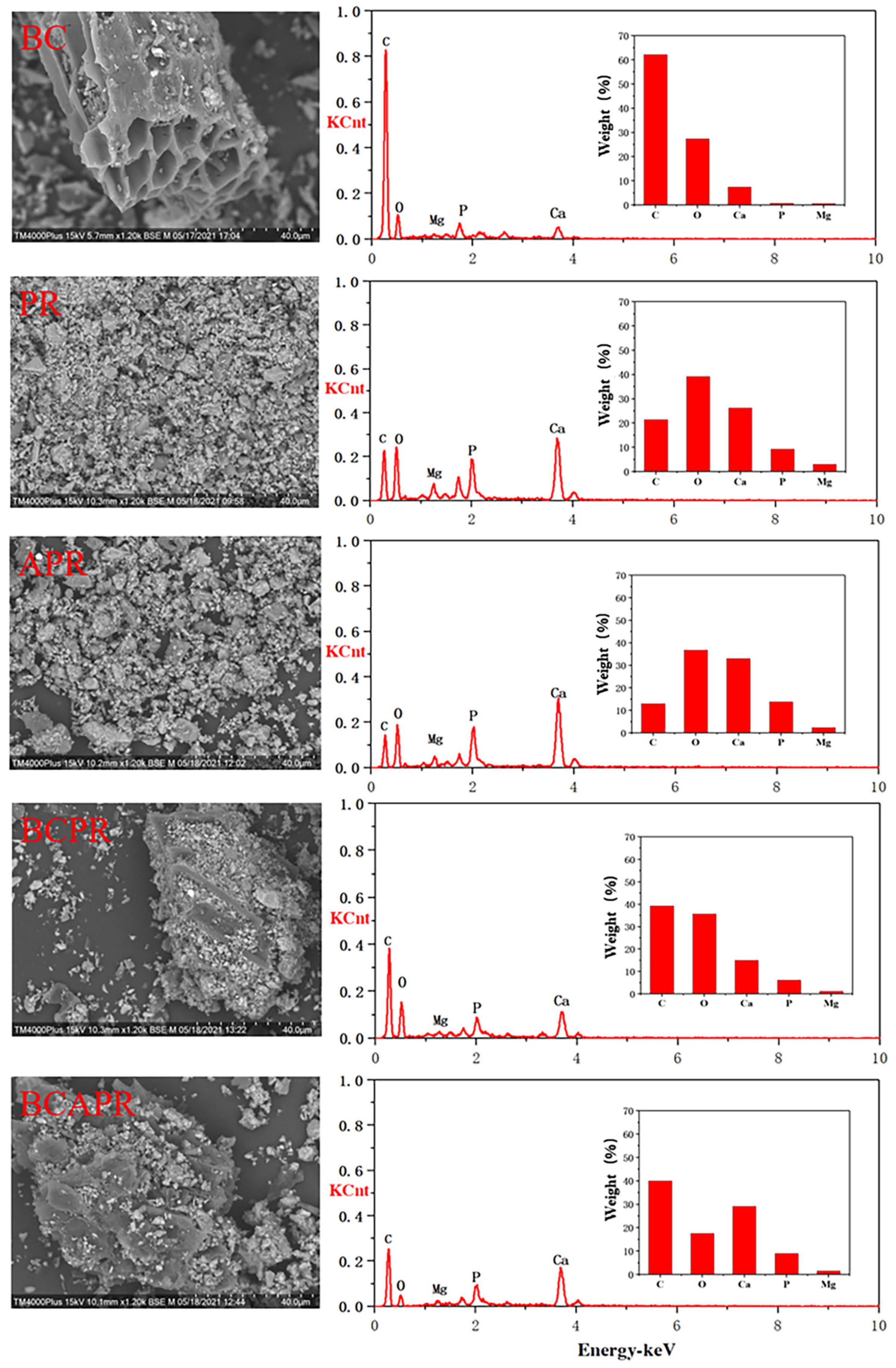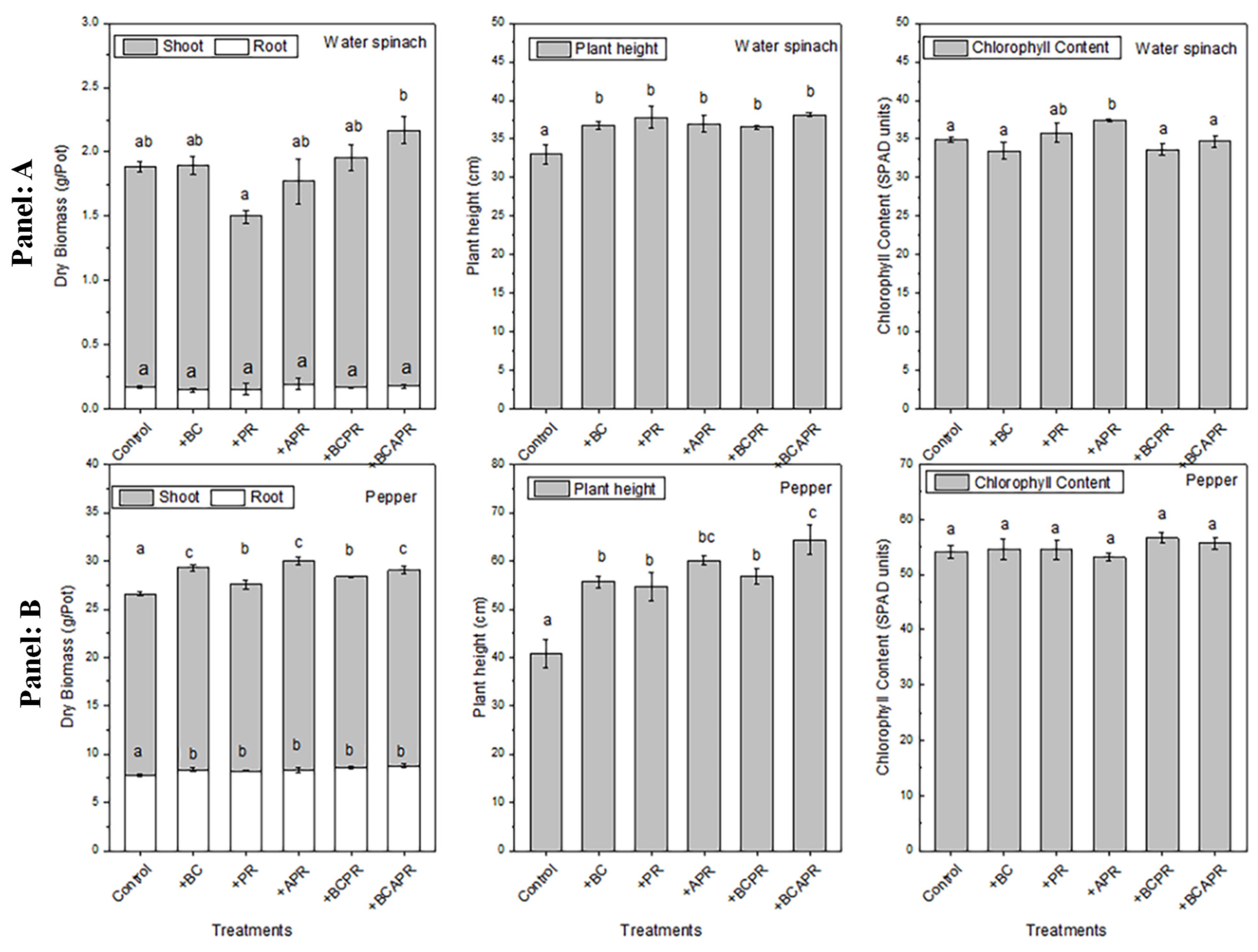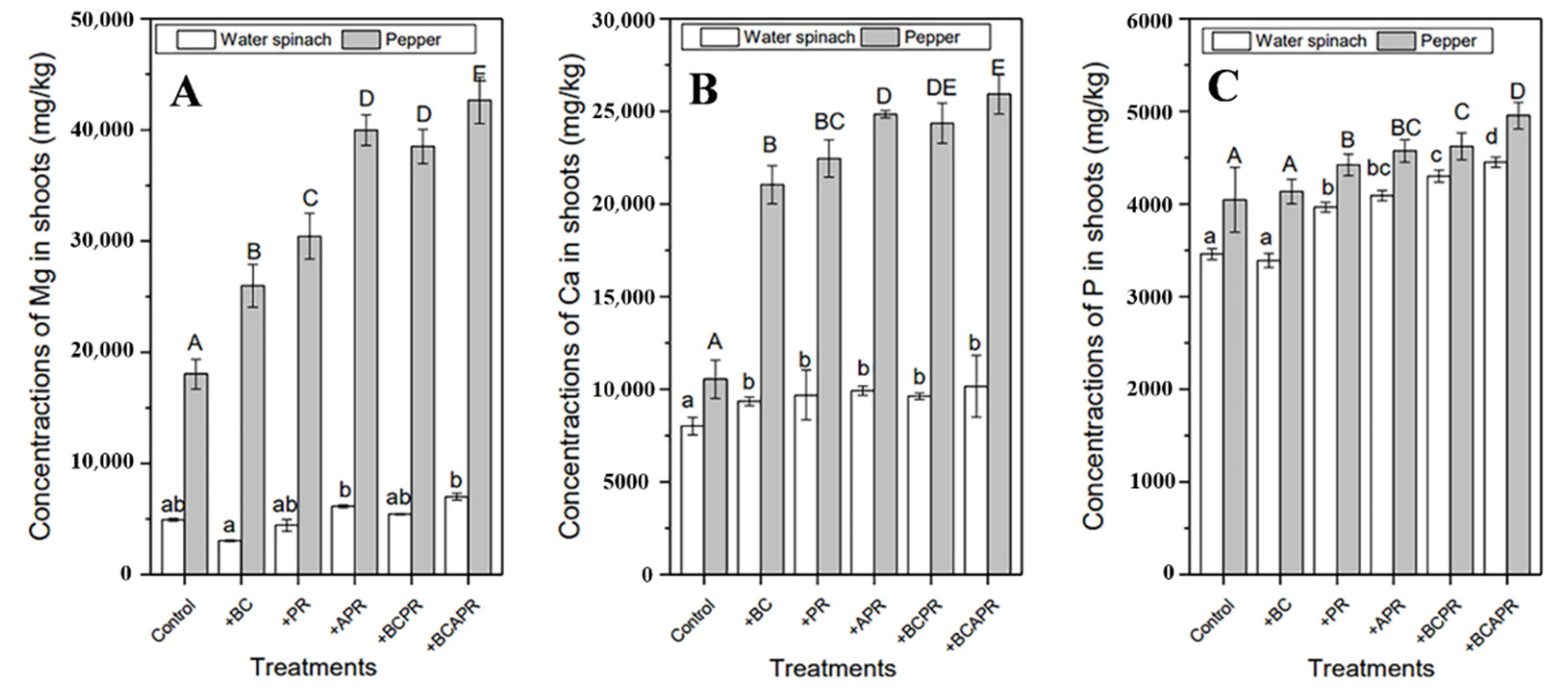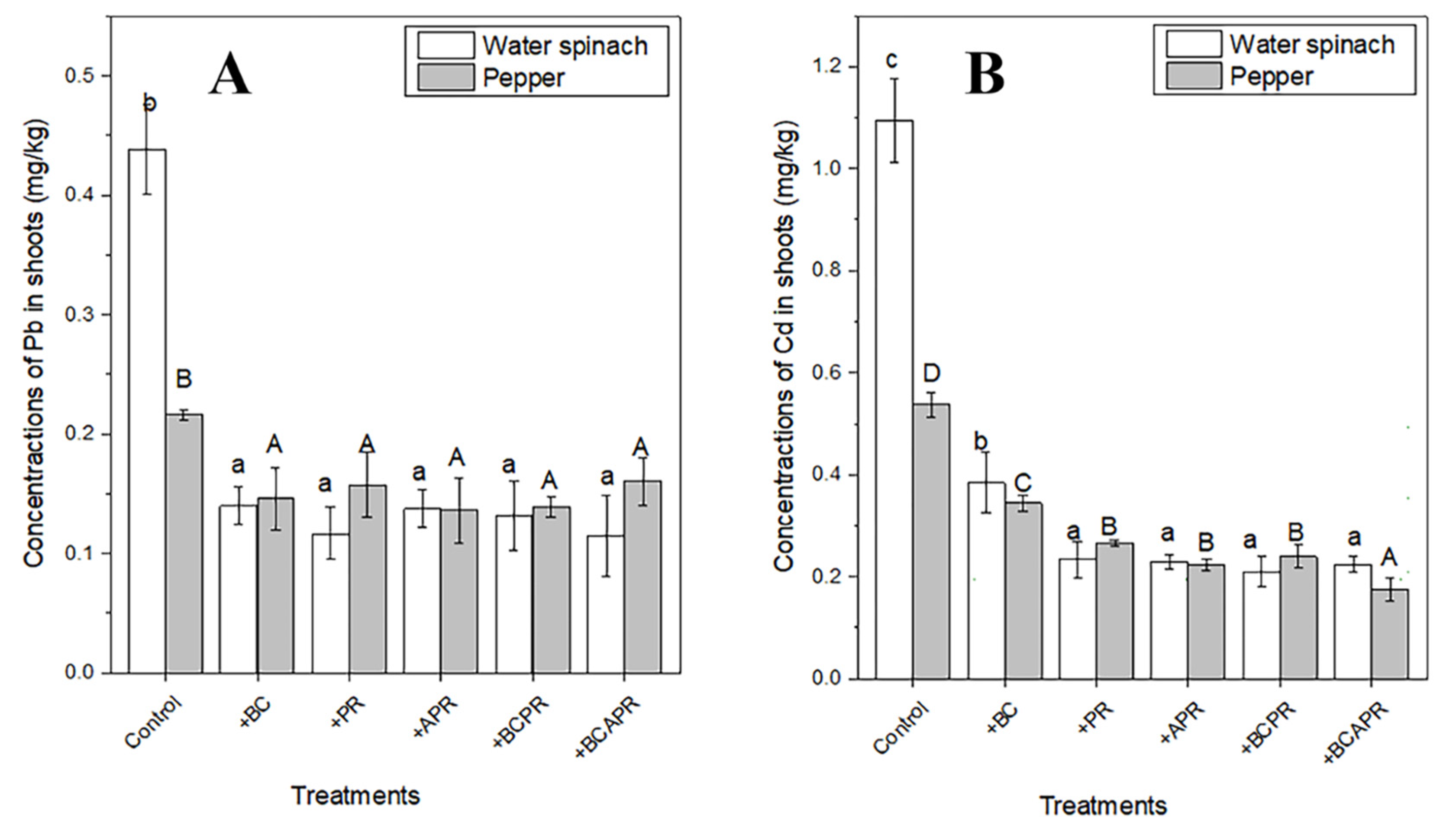The Synergistic Effect of Biochar-Combined Activated Phosphate Rock Treatments in Typical Vegetables in Tropical Sandy Soil: Results from Nutrition Supply and the Immobilization of Toxic Metals
Abstract
:1. Introduction
2. Materials and Methods
2.1. Study Area, Soil, and Materials
2.2. Preparation and Characterization of Amendments
2.3. Pot Experiment
2.4. Analysis of Soil and Vegetable
2.5. Statistical Analysis
3. Results
3.1. Characterization of Soil Amendment
3.2. Effects of Amendments on Soil Characteristics
3.3. Plant Growth, Biomass, and Nutrient Uptake
3.4. Effects of Amendments on Cd and Pb Uptake
4. Discussion
4.1. The Synergistic Mechanisms of Biochar and Activated Phosphate Rock on Agronomic Effects
4.2. The Synergistic Mechanisms of Biochar and Activated Phosphate Rock on Cd and Pb Immobilization
5. Conclusions
Supplementary Materials
Author Contributions
Funding
Institutional Review Board Statement
Informed Consent Statement
Data Availability Statement
Acknowledgments
Conflicts of Interest
References
- Croker, J.; Poss, R.; Hartmann, C.; Bhuthorndharaj, S. Effects of recycled bentonite addition on soil properties, plant growth and nutrient uptake in a tropical sandy soil. Plant Soil 2004, 267, 155–163. [Google Scholar] [CrossRef]
- Fujii, K.; Hayakawa, C.; Panitkasate, T.; Maskhao, I.; Funakawa, S.; Kosaki, T.; Nawata, E. Acidification and buffering mechanisms of tropical sandy soil in northeast Thailand. Soil Tillage Res. 2017, 165, 80–87. [Google Scholar] [CrossRef]
- Rafael, R.B.A.; Fernandez-Marcos, M.L.; Cocco, S.; Ruello, M.L.; Fornasier, F.; Corti, G. Increased phosphorus availability to corn resulting from the simultaneous applications of phosphate rock, calcareous rock, and biochar to an acid sandy soil. Pedosphere 2020, 30, 719–733. [Google Scholar] [CrossRef]
- de Oliveira, L.E.Z.; Nunes, R.D.; de Sousa, D.M.G.; de Figueiredo, C.C. Dynamics of residual phosphorus forms under different tillage systems in a Brazilian Oxisol. Geoderma 2020, 367, 114254. [Google Scholar] [CrossRef]
- He, Z.L.; Zhang, M.; Yang, X.E.; Stoffella, P.J. Release behavior of copper and zinc from sandy soils. Soil Sci. Soc. Am. J. 2006, 70, 1699–1707. [Google Scholar] [CrossRef]
- Zhang, M.-K.; He, Z.-L.; Calvert, D.V.; Stoffella, P.J. Extractability and mobility of copper and zinc accumulated in sandy soils1 1project partly supported by the u.s. environmental protection agency through a contract with the nonpoint source management/water quality standard section of the florida department of environmental protection (No. WM746). Pedosphere 2006, 16, 43–49. [Google Scholar]
- Yang, Y.G.; He, Z.L.; Yang, X.E.; Fan, J.H.; Stoffella, P.; Brittain, C. Dolomite phosphate rock-based slow-release fertilizer for agriculture and landscapes. Commun. Soil Sci. Plant Anal. 2012, 43, 1344–1362. [Google Scholar] [CrossRef]
- Jiang, G.J.; Liu, Y.H.; Huang, L.; Fu, Q.L.; Deng, Y.J.; Hu, H.Q. Mechanism of lead immobilization by oxalic acid-activated phosphate rocks. J. Environ. Sci. 2012, 24, 919–925. [Google Scholar] [CrossRef]
- Seshadri, B.; Bolan, N.S.; Choppala, G.; Kunhikrishnan, A.; Sanderson, P.; Wang, H.; Currie, L.D.; Tsang, D.C.W.; Ok, Y.S.; Kim, G. Potential value of phosphate compounds in enhancing immobilization and reducing bioavailability of mixed heavy metal contaminants in shooting range soil. Chemosphere 2017, 184, 197–206. [Google Scholar] [CrossRef]
- Zhang, Z.; Guo, G.L.; Wang, M.; Zhang, J.; Wang, Z.X.; Li, F.S.; Chen, H.H. Enhanced stabilization of Pb, Zn, and Cd in contaminated soils using oxalic acid-activated phosphate rocks. Environ. Sci. Pollut. Res. 2018, 25, 2861–2868. [Google Scholar] [CrossRef]
- Huang, G.Y.; Gao, R.L.; You, J.W.; Zhu, J.; Fu, Q.L.; Hu, H.Q. Oxalic acid activated phosphate rock and bone meal to immobilize Cu and Pb in mine soils. Ecotoxicol. Environ. Saf. 2019, 174, 401–407. [Google Scholar] [CrossRef] [PubMed]
- Mao, X.Y.; Lu, Q.; Mo, W.; Xin, X.P.; Chen, X.; He, Z.L. Phosphorus availability and release pattern from activated dolomite phosphate rock in central florida. J. Agric. Food Chem. 2017, 65, 4589–4596. [Google Scholar] [CrossRef] [PubMed]
- Zeng, G.M.; Wan, J.; Huang, D.L.; Hu, L.; Huang, C.; Cheng, M.; Xue, W.J.; Gong, X.M.; Wang, R.Z.; Jiang, D.N. Precipitation, adsorption and rhizosphere effect: The mechanisms for phosphate-induced Pb immobilization in soils—A review. J. Hazard Mater. 2017, 339, 354–367. [Google Scholar] [CrossRef] [PubMed]
- Zhao, L.; Ding, Z.L.; Sima, J.K.; Xu, X.Y.; Cao, X.D. Development of phosphate rock integrated with iron amendment for simultaneous immobilization of Zn and Cr(VI) in an electroplating contaminated soil. Chemosphere 2017, 182, 15–21. [Google Scholar] [CrossRef]
- Xu, Q.; Ye, B.H.; Mou, X.Y.; Ye, J.; Liu, W.Y.; Luo, Y.T.; Shi, J.Y. Lead was mobilized in acid silty clay loam paddy soil with potassium dihydrogen phosphate (KDP) amendment. Environ. Pollut. 2019, 255, 113179. [Google Scholar] [CrossRef]
- Rasool, B.; ur-Rahman, M.; Ramzani, P.M.A.; Zubair, M.; Khan, M.A.; Lewinska, K.; Turan, V.; Karczewska, A.; Khan, S.A.; Farhad, M.; et al. Impacts of oxalic acid-activated phosphate rock and root-induced changes on Pb bioavailability in the rhizosphere and its distribution in mung bean plant. Environ. Pollut. 2021, 280, 116903. [Google Scholar] [CrossRef]
- Yu, Y.; Xiong, J.B.; Liu, R.L.; He, Z.L. Release of heavy metals from dolomite phosphate rock after activation with organic agent. J. Environ. Qual. 2019, 48, 694–700. [Google Scholar] [CrossRef]
- Wang, X.L.; Xiong, J.B.; He, Z.L. Activated dolomite phosphate rock fertilizers to reduce leaching of phosphorus and trace metals as compared to superphosphate. J. Environ. Manag. 2020, 255, 109872. [Google Scholar] [CrossRef]
- Shao, X.Q.; Yao, H.L.; Cui, S.A.; Peng, Y.T.; Gao, X.; Yuan, C.P.; Chen, X.; Hu, Y.M.; Mao, X.Y. Activated low-grade phosphate rocks for simultaneously reducing the phosphorus loss and cadmium uptake by rice in paddy soil. Sci. Total Environ. 2021, 780, 146550. [Google Scholar] [CrossRef]
- Agegnehu, G.; Srivastava, A.K.; Bird, M.I. The role of biochar and biochar-compost in improving soil quality and crop performance: A review. Appl. Soil Ecol. 2017, 119, 156–170. [Google Scholar] [CrossRef]
- Shaaban, M.; Van Zwieten, L.; Bashir, S.; Younas, A.; Nunez-Delgado, A.; Chhajro, M.A.; Kubar, K.A.; Ali, U.; Rana, M.S.; Mehmood, M.A.; et al. A concise review of biochar application to agricultural soils to improve soil conditions and fight pollution. J. Environ. Manag. 2018, 228, 429–440. [Google Scholar] [CrossRef] [PubMed]
- Yu, H.W.; Zou, W.X.; Chen, J.J.; Chen, H.; Yu, Z.B.; Huang, J.; Tang, H.R.; Wei, X.Y.; Gao, B. Biochar amendment improves crop production in problem soils: A review. J. Environ. Manag. 2019, 232, 8–21. [Google Scholar] [CrossRef] [PubMed]
- Shao, S.; Ma, B.; Ai, L.; Tian, X.; Zhang, L. Foliar spraying of selenium combined with biochar alleviates cadmium toxicity in peanuts and enriches selenium in peanut grains. Int. J. Environ. Res. Public Health 2022, 19, 3542. [Google Scholar] [CrossRef] [PubMed]
- Leite, A.D.; Cardoso, A.A.D.; Leite, R.D.; de Oliveira-Longatti, S.M.; Lustosa, J.F.; Moreira, F.M.D.; Melo, L.C.A. Selected bacterial strains enhance phosphorus availability from biochar-based rock phosphate fertilizer. Ann. Microbiol. 2020, 70, 6. [Google Scholar] [CrossRef]
- Lustosa, J.F.; Barbosa, C.F.; Carneiro, J.S.D.; Melo, L.C.A. Diffusion and phosphorus solubility of biochar-based fertilizer: Visualization, chemical assessment and availability to plants. Soil Tillage Res. 2019, 194, 104298. [Google Scholar] [CrossRef]
- Lustosa, J.F.; Penido, E.S.; Castro, P.P.; Silva, C.A.; Melo, L.C.A. Co-Pyrolysis of poultry litter and phosphate and magnesium generates alternative slow-release fertilizer suitable for tropical soils. ACS Sustain. Chem Eng. 2017, 5, 9043–9052. [Google Scholar] [CrossRef]
- Liu, M.H.; Che, Y.Y.; Wang, L.Q.; Zhao, Z.J.; Zhang, Y.C.; Wei, L.L.; Xiao, Y. Rice straw biochar and phosphorus inputs have more positive effects on the yield and nutrient uptake of lolium multiflorum than arbuscular mycorrhizal fungi in acidic Cd-contaminated soils. Chemosphere 2019, 235, 32–39. [Google Scholar] [CrossRef]
- Liu, B.B.; He, Z.L.; Liu, R.L.; Montenegro, A.C.; Ellis, M.; Li, Q.F.; Baligar, V.C. Comparative effectiveness of activated dolomite phosphate rock and biochar for immobilizing cadmium and lead in soils. Chemosphere 2021, 266, 129202. [Google Scholar] [CrossRef]
- Madeira, A.C.; Varennes, A.D. Use of chlorophyll meter to assess the effect of nitrogen on sweet pepper development and growth. J. Plant Nutr. 2005, 28, 1133–1144. [Google Scholar] [CrossRef]
- Padilla, F.M.; de Souza, R.; Pena-Fleitas, M.T.; Gallardo, M.; Gimenez, C.; Thompson, R.B. Different responses of various chlorophyll meters to increasing nitrogen supply in sweet pepper. Front. Plant Sci. 2018, 9, 1752. [Google Scholar] [CrossRef] [Green Version]
- Mehlich, A. Mehlich 3 soil test extractant: A modification of Mehlich 2 extractant. Commun. Soil Sci. Plant Anal. 1984, 15, 1409–1416. [Google Scholar] [CrossRef]
- Buates, J.; Imai, T. Application of biochar functionalized with layered double hydroxides: Improved plant growth performance after use as phosphate adsorbent. Appl. Sci. 2021, 11, 6489. [Google Scholar] [CrossRef]
- Pogorzelski, D.; Lustosa, J.F.; Matias, P.C.; Santos, W.O.; Vergutz, L.; Melo, L.C.A. Biochar as composite of phosphate fertilizer: Characterization and agronomic effectiveness. Sci. Total Environ. 2020, 743, 140604. [Google Scholar] [CrossRef] [PubMed]
- Tumbure, A.; Bishop, P.; Bretherton, M.; Hedley, M. Co-Pyrolysis of maize stover and igneous phosphate rock to produce potential biochar-based phosphate fertilizer with improved carbon retention and liming value. ACS Sustain. Chem. Eng. 2020, 8, 4178–4184. [Google Scholar] [CrossRef]
- Wang, Q.J.; Xu, L.P.; Guo, D.J.; Wang, G.F.; Song, X.C.; Ma, Y. The continuous application of biochar in field: Effects on P fraction, P sorption and release. Chemosphere 2021, 263, 128084. [Google Scholar] [CrossRef] [PubMed]
- Kannan, P.; Paramasivan, M.; Marimuthu, S.; Swaminathan, C.; Bose, J. Applying both biochar and phosphobacteria enhances Vigna mungo L. growth and yield in acid soils by increasing soil pH, moisture content, microbial growth and P availability. Agric. Ecosyst. Environ. 2021, 308, 107258. [Google Scholar]
- Austruy, A.; Shahid, M.; Xiong, T.T.; Castrec, M.; Payre, V.; Niazi, N.K.; Sabir, M.; Dumat, C. Mechanisms of metal-phosphates formation in the rhizosphere soils of pea and tomato: Environmental and sanitary consequences. J. Soil Sediment 2014, 14, 666–678. [Google Scholar] [CrossRef] [Green Version]
- Vandecasteele, B.; Willekens, K.; Zwertvaegher, A.; Degrande, L.; Tack, F.M.G.; Du Laing, G. Effect of composting on the Cd, Zn and Mn content and fractionation in feedstock mixtures with wood chips from a short-rotation coppice and bark. Waste Manag. 2013, 33, 2195–2203. [Google Scholar] [CrossRef]
- Rong, Q.; Zhong, K.; Huang, H.; Li, C.Z.; Zhang, C.L.; Nong, X.Y. Humic acid reduces the available cadmium, copper, lead, and zinc in soil and their uptake by tobacco. Appl. Sci.-Basel 2020, 10, 1077. [Google Scholar] [CrossRef] [Green Version]
- Luo, Y.; Li, Z.P.; Xu, H.C.; Xu, X.Y.; Qiu, H.; Cao, X.D.; Zhao, L.G. Development of phosphorus composite biochar for simultaneous enhanced carbon sink and heavy metal immobilization in soil. Sci. Total Environ. 2022, 831, 154845. [Google Scholar] [CrossRef]





| pH | Organic Matter (mg/kg) | Available P (mg/kg) | Available Ca (mg/kg) | Available Mg (mg/kg) | Extractable Cd (μg/kg) | Extractable Pb (μg/kg) | |
|---|---|---|---|---|---|---|---|
| First crop | |||||||
| Control | 5.54 ± 0.05 a | 8.14 ± 0.56 a | 66.31 ± 4.46 a | 6.22 ± 1.02 a | 23.51 ± 0.47 a | 10.10 ± 0.15 d | 33.20 ± 0.64 b |
| +BC | 6.95 ± 0.05 c | 9.73 ± 0.12 b | 56.48 ± 5.22 a | 287.21 ± 15.61 b | 31.22 ± 2.62 a | 3.02 ± 0.48 c | 23.10 ± 1.12 a |
| +PR | 7.60 ± 0.11 d | 8.44 ± 0.14 ab | 103.26 ± 3.75 b | 385.27 ± 3.55 c | 102.27 ± 3.78 b | 2.31 ± 0.09 bc | 26.90 ± 0.54 b |
| +APR | 6.71 ± 0.09 b | 9.03 ± 0.20 abc | 103.21 ± 4.53 b | 447.34 ± 15.21 d | 160.09 ± 13.31 c | 1.46 ± 0.20 a | 23.00 ± 0.19 a |
| +BCPR | 7.65 ± 0.02 d | 9.63 ± 0.39 bc | 112.17 ± 1.31 b | 452.08 ± 19.48 de | 187.24 ± 4.88 d | 1.73 ± 0.28 ab | 22.60 ± 1.09 a |
| +BCAPR | 6.78 ± 0.01 bc | 10.30 ± 0.87 c | 124.09 ± 1.62 c | 490.17 ± 12.07 e | 219.33 ± 7.06 e | 1.35 ± 0.06 a | 20.20 ± 1.38 a |
| Second crop | |||||||
| Control | 4.81 ± 0.10 a | 8.54 ± 0.07 b | 68.62 ± 4.64 a | 8.89 ± 0.54 a | 25.32 ± 0.47 a | 5.31 ± 0.34 d | 34.50 ± 1.89 b |
| +BC | 7.34 ± 0.03 d | 10.10 ± 0.22 c | 70.08 ± 3.85 a | 329.15 ± 27.12 b | 75.69 ± 6.25 b | 4.04 ± 0.41 c | 29.10 ± 1.82 a |
| +PR | 7.59 ± 0.09 e | 7.45 ± 0.20 a | 121.12 ± 4.61 b | 358.06 ± 22.58 b | 125.43 ± 11.21 c | 3.49 ± 0.17 bc | 27.90 ± 1.59 a |
| +APR | 6.29 ± 0.04 b | 8.87 ± 0.09 b | 116.31 ± 4.15 b | 733.32 ± 62.43 c | 192.26 ± 2.54 d | 2.69 ± 0.42 b | 25.90 ± 0.71 a |
| +BCPR | 7.78 ± 0.01 f | 9.09 ± 0.20 b | 121.24 ± 0.73 b | 808.11 ± 5.62 cd | 229.12 ± 3.51 e | 1.48 ± 0.10 a | 26.08 ± 1.09 a |
| +BCAPR | 6.64 ± 0.03 c | 10.10 ± 0.62 c | 147.32 ± 22.31 b | 875.24 ± 7.18 d | 256.34 ± 4.69 f | 0.86 ± 0.06 a | 25.80 ± 1.03 a |
Publisher’s Note: MDPI stays neutral with regard to jurisdictional claims in published maps and institutional affiliations. |
© 2022 by the authors. Licensee MDPI, Basel, Switzerland. This article is an open access article distributed under the terms and conditions of the Creative Commons Attribution (CC BY) license (https://creativecommons.org/licenses/by/4.0/).
Share and Cite
Zhang, Z.; Liu, B.; He, Z.; Pan, P.; Wu, L.; Lin, B.; Li, Q.; Zhang, X.; Wang, Z. The Synergistic Effect of Biochar-Combined Activated Phosphate Rock Treatments in Typical Vegetables in Tropical Sandy Soil: Results from Nutrition Supply and the Immobilization of Toxic Metals. Int. J. Environ. Res. Public Health 2022, 19, 6431. https://doi.org/10.3390/ijerph19116431
Zhang Z, Liu B, He Z, Pan P, Wu L, Lin B, Li Q, Zhang X, Wang Z. The Synergistic Effect of Biochar-Combined Activated Phosphate Rock Treatments in Typical Vegetables in Tropical Sandy Soil: Results from Nutrition Supply and the Immobilization of Toxic Metals. International Journal of Environmental Research and Public Health. 2022; 19(11):6431. https://doi.org/10.3390/ijerph19116431
Chicago/Turabian StyleZhang, Zhiwei, Beibei Liu, Zhenli He, Pan Pan, Lin Wu, Bigui Lin, Qinfen Li, Xinchun Zhang, and Zhikang Wang. 2022. "The Synergistic Effect of Biochar-Combined Activated Phosphate Rock Treatments in Typical Vegetables in Tropical Sandy Soil: Results from Nutrition Supply and the Immobilization of Toxic Metals" International Journal of Environmental Research and Public Health 19, no. 11: 6431. https://doi.org/10.3390/ijerph19116431







